

Acorn-User-guide. An Overview of China’s Retail Industry - China Briefing News. By Eunice Ku, Dezan Shira & Associates The following is an excerpt from the April 2014 edition of China Briefing Magazine, titled “China Retail Industry Report 2014.”
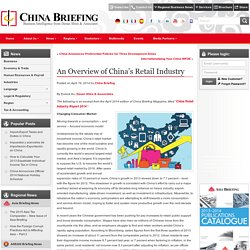
Changing Consumer Market Moving towards a consumption – and service – focused economic model Underpinned by the steady rise of household income, China’s retail market has become one of the most lucrative and rapidly growing in the world. China is currently the world’s second largest retail market, and Asia’s largest. In recent years the Chinese government has been pushing for pay increases to retain public support and boost domestic consumption. With more money flowing into Chinese households, consumption levels have experienced a marked increase. According to Nielsen, the top four areas where tier-two and three consumers are using their spare cash are on new clothes, dining out, education funds, and into saving deposits. U.K.’s Reliance on Consumer Spending Raises Questions About Recovery - WSJ.
Chinese shoppers choose to buy British online.
OMNI - CHANNEL RETAILING. Uk-cb-the-omnichannel-opportunity. How webrooming and omnichannel retail is bringing customers back in-store. There has been an undeniable change in people’s buying habits in recent years, with how consumers choose to buy and research products evolving as technology does.
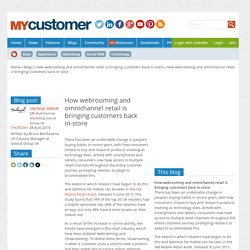
Armed with smartphones and tablets, consumers now have access to multiple retail channels throughout the entire customer journey, prompting retailers to adapt to accommodate this. The extent in which retailers have begun to do this and optimise for mobile can be seen in the IAB Mobile Retail Audit, released in June 2013. The study found that 74% of the top 50 UK retailers had a mobile optimised site, 64% of the retailers have an app, but only 48% have a store locator on their mobile site.
As a result of the increase in online activity, two trends have emerged in the retail industry, which have been dubbed ‘webrooming’ and ‘showrooming’. Uk-cb-consumer-review-edition-6.pdf. Follow Their Journey: The Changing Consumer Buying Landscape and the Research Methods Needed To Map It. Technology is radically changing how consumers gather information and purchase.
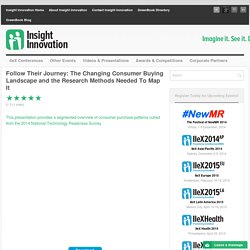
For example, instead of visiting a store/website to purchase in a single step, a consumer is likely to embark on a journey spanning multiple touch points, information sources, social networks, purchase channels and technologies. In this shifting and increasingly complex landscape, managers demand information from insights professionals to make effective decisions on communications and channel strategy. In this presentation, research leader Gina Woodall provides a segmented overview of consumer purchase patterns culled from the 2014 National Technology Readiness Survey. Shopping Then and Now: Five Ways Retail Has Changed and How Businesses Can Adapt. Constant connectivity, contextual relevance, and a multi-screen world are changing both online and offline shopping.

As the digital and in-store experiences blur, it is opening up exciting new possibilities for forward-thinking retailers. Sridhar Ramaswamy, who as Google's SVP of Ads and Commerce oversees the technology behind Google Shopping, explains how combining classic retail truths with digital savvy can help retailers do what matters most: serve their customers better. Written by. Consumerism and the Department Store. Holiday frenzy as depicted in Puck, a humor and satire magazine, 1913.

In 1939, Thanksgiving fell on the last day of November and Franklin Roosevelt worried that the delay of the Christmas shopping season would hurt the economy. He issued a Presidential Proclamation stating that Thanksgiving would be celebrated on the second to last Thursday of the month, a tactic aimed to boost retails sales and extend the holiday shopping period. However, some states adopted the new date and others did not, creating an odd mix of celebration dates. In 1941 Congress ended up passing legislation to have Thanksgiving on the fourth Thursday of the month to make sure the holiday shopping season could begin reasonably early. Today it seems the holiday retail push begins earlier every year with candy canes and twinkle lights sitting next to Halloween masks and fun size bars in October.
I found it interesting that FDR had similar worries about the holiday retail season in the 1930s. A Shopping Experience A.T. 5 Strategies for Keeping Pace with Changing Customer Buying Behavior. 5 Strategies for Keeping Pace with Changing Customer Buying Behaviors Customer buying behaviors are changing.
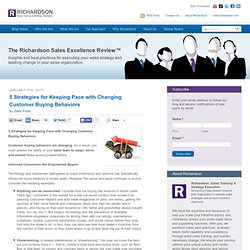
As a result, you must assess the ability of your sales team to adapt, serve, and exceed these evolving expectations. Informed Consumers Are Empowered Buyers Technology and consumers’ willingness to share information and opinions has dramatically influenced buyer behavior in recent years. However, the nature and pace continues to evolve. Anything can be researched. Although the changing buyer behavior has been fueled by the B2C market, don’t be fooled into thinking that it has not permeated B2B and service providers. 7 Characteristics of Changing Consumer Buying Behaviors. Consumer buying behavior is different today than it was 10 years ago.
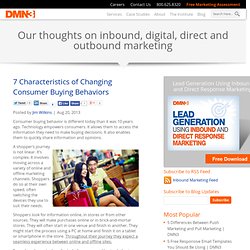
Technology empowers consumers. It allows them to access the information they need to make buying decisions. It also enables them to quickly share information and opinions. A shopper’s journey is not linear. It’s complex. Customer 2.0: The Changing Nature of Buyer Behavior. 6612386.pdf.